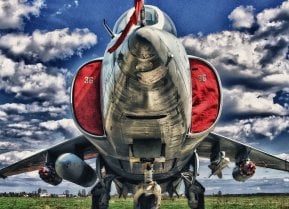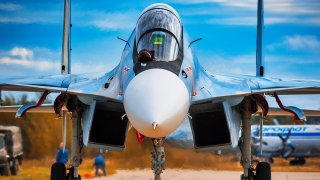Russia's Su-30SM2 Fighter Jet Looks Like the Real Deal
The Su-30SM multi-role fighter jet was derived from Russia’s earlier Su-30 variant. It could do some real damage in the Ukriane war.
Months back, Russia’s sophisticated Su-30SM and Su-30SM2 fighter airframes completed a set of training drills over the Kaliningrad Region, according to the state-run media outlet TASS News Agency. In these Baltic Drills, at least ten Russian jets performed tactical exercises with bombing and missile strikes.
The Baltic Fleet’s press office issued a statement on the aerial drills: “During the drills, the pilots are exercising to destroy enemy military hardware columns, command posts and amassed manpower, military-industrial facilities, adversary aircraft, airborne and amphibious assault forces, and also to provide fire support to units of the Baltic Fleet’s army corps.”
Although Moscow’s fleet of fighter platforms have been largely underwhelming throughout the year-long invasion of Ukraine, the country's fleet of Su-30SM fighters has served in many of its offensive operations in Ukraine.
A brief overview of the Su-30SM’s origins
The Su-30SM multi-role fighter jet was derived from Russia’s earlier Su-30 variant.
Initially developed in the Soviet Union by manufacturer Sukhoi Aviation Corporation, the twin-engine supermaneuverable airframe remains a staple in Russia’s aerial strategy. Similar to most of Russia’s more modern jets, the Su-30 is a descendant of the Sukhoi-27 airframe. Designated as “Flanker” by the North Atlantic Treaty Organization (NATO), the Su-27 was designed specifically to counter American-made fourth-generation fighters the Grumman F-14 Tomcat and the McDonnell Douglas F-15 Eagle.
Although the Flanker hosted significant capabilities and had decent range, the Soviet Air Defense Forces sought a newer fighter that could trek across the whole country without the need for refueling. Ultimately, the USSR’s Su-27PU fulfilled the Air Force’s range needs and was later renamed the Su-30 by Russia’s Defense Ministry. The Su-30 performed well after entering service in the mid-to-late 1990’s and Russia’s Defense Ministry opted to order 60 Su-30SM variants in 2012. The Su-30SM is powered by two Al-31FP by-ass turbojet engines and can reach a top flight speed of Mach 2.0.
Featuring an improved radar, communication system and weapons system, the Su-30SM is a more capable airframe than its predecessor. The airframe of the Su-30SM is made of titanium and high-strength aluminum alloys.
According to Air Force Technology, “The Sukhoi Su-30SM features identification friend-or-foe equipment, a global positioning system and an inertial navigation system. The open architecture design allows the integration of modern avionics, including a new radar system, radio and recognition system and other support systems.”
Moscow has deployed Su-30SM fighters to Ukraine
Su-30SM airframes have been paired with Su-35 fighters to carry out patrols and military operations in Ukraine. Experts told the Bulgarian Military outlet that the Su-30SM is being used to shield Russian bombers in Ukraine by acting as distractors.
Su-30SM pilots engage Ukrainian attention while “high-flying bombers can carry out bombing runs.”
Last year, the Russian military received its first batch of Su-30SM2 heavyweight fighters, the latest variant in the Su-30 family.
Russia’s Su-30MK series of fighters have been exported around the globe. The Armenian Air Force, Indian Air Force, People’s Liberation Army Air Force and several other nations possess advanced derivatives of the platform.
As the invasion lags on, Moscow will continue to utilize its Su-30Sm fighters to aid its war efforts against Ukraine.
About the Author
Maya Carlin is an analyst with the Center for Security Policy and a former Anna Sobol Levy Fellow at IDC Herzliya in Israel. She has by-lines in many publications, including The National Interest, Jerusalem Post, and Times of Israel.
All images are Creative Commons.


